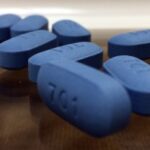The Food and Drug Administration issued a warning in late October 2023 urging consumers to avoid purchasing and to immediately stop using 26 over-the-counter eye drop products because of risk of eye infection that could result in partial vision loss or even blindness. More products were soon added to the list, and a few others have been voluntarily recalled. No cases of eye infection from the products have been reported as of mid-November 2023. It’s just the latest in a series of warnings and recalls related to bacterial or fungal contamination of these products.
The Conversation spoke with assistant professor of infectious diseases Alexander Sundermann and Daria Van Tyne, an assistant professor of medicine – both from the University of Pittsburgh – to explain how such contamination can occur and what consumers can do to protect themselves.
What prompted the latest warning?
The latest FDA warning was issued in response to alarming findings from a recent inspection of an as yet unidentified eye drop manufacturing facility.
The inspection found unsanitary conditions within the facility and detected “positive bacterial test results from environmental sampling of critical drug production areas.”
However, specific details about the type of bacteria, its source within the facility, the types of contamination found, the precise conditions leading to contamination or any infections associated with this alert have not been disclosed as of mid-November 2023.
This latest alert is similar to warnings about contaminated eye drops reported earlier this year that ultimately caused an outbreak of 81 infections and four deaths. Following the February outbreak, the FDA provided a comprehensive account of nonsterile conditions at a manufacturing facility in India that made the eye drop products sold in the U.S.
This new alert is defined as “contamination” in the processing area. Essentially, the FDA sampled the facility’s working environment and found bacterial growth where it should not be growing. The contamination does not yet mean there is an outbreak, defined as any infections caused from the contamination.
There could be infections associated with this new alert, but neither the FDA nor the Centers for Disease Control and Prevention has released any details as of mid-November 2023. During medication or device contamination or outbreaks, the CDC and the FDA work together to pinpoint the issues and prevent or control spread.
The February 2023 outbreak had both unsanitary conditions and contaminated eye drops – not just contamination in the environment – that also clearly caused infections and deaths. Essentially, this new alert could be a precursor to an outbreak that is cause for concern.
What has led to the spate of eye drop contaminations this year?
The recent alerts of eye drop contamination may be a result of several key factors.
First, the outbreak from February 2023 came to light when a previously unknown strain of antibiotic-resistant bacteria began cropping up across the U.S. Federal investigators were prompted to intervene, and they employed a sophisticated genomic fingerprinting approach to connect cases associated with contaminated eye drop use.
Second, more than 50% of drugs consumed in the U.S. are produced overseas, but at the height of the COVID-19 pandemic, the FDA sharply curtailed its ongoing inspections of international manufacturing facilities. Although the reduction in oversight was temporary, it may have allowed product contamination to go unchecked.
Finally, until this year, infections from contaminated eye drops were rare. Given the glaring sterility issues it found in the manufacturing process during its initial inspections, the FDA was prompted to do further investigation, and found yet more issues – which may have led to the increase in alerts.
Why is this type of bacterial contamination potentially dangerous?
Our bodies possess natural defense systems. Our skin, for example, acts as a barrier that stops bacteria from causing infections.
But eye drops containing pathogens can bypass these safeguards and introduce resistant bacteria directly into the susceptible environment of the eye. There, they can cause severe infections that are difficult to treat with conventional antibiotics.
This past February’s outbreak and the four tragic deaths resulting from it highlight the peril of bacterial contamination in consumer products. The specific strain involved – Pseudomonas aeruginosa – displayed an alarming resistance to multiple antibiotics, even those typically used as last-resort treatments.
This resistance makes it harder to treat these infections effectively. In response, some health care institutions are using experimental treatments like bacteriophage therapy as a way to combat these extremely drug-resistant pathogens. Essentially, phage therapy uses bacteria-killing viruses to treat antibiotic-resistant infections.
The contaminated eye drops were also free of preservatives, which further increased contamination risk. Preservatives help prevent the growth of harmful bacteria within eye drop containers.
Why might some of these products remain on shelves?
Recalling a product is typically a long and laborious process. When the FDA issues a recall notice, it must work with the manufacturing facility to track all affected batches. This requires the cooperation of multiple entities, including distributors and retail outlets, which must physically remove products from the shelves and online.
What’s more, a speedy removal of the eye drop products may be further hampered by the FDA’s lack of investigators, a decline that began in 2016. As the FDA continues to carry out inspections, more recalls could occur.
How can detection of these contamination issues be improved?
Unfortunately, contaminated medications and medical products are not uncommon. Just in 2023, a tuberculosis outbreak linked to contaminated bone graft material, as well as a large fungal outbreak related to epidural anesthesia, have occurred.
Detecting these cases is difficult. However, our research team performs genomic fingerprinting on nearly all bacterial infections at our hospital. Genomic fingerprinting lets researchers see if multiple patients have the same infection, which would indicate they are part of an outbreak. It is key to detecting outbreaks at an earlier stage.
In October, 2022, about four months prior to the announcement of the eye drop outbreak, our team found two cases of the drug-resistant bacterium Pseudomonas aeruginosa through genomic fingerprinting. Once the CDC shared details of its investigation, we were able to connect these patients to the larger outbreak.
If more hospitals and public health institutions adopted the use of genomic fingerprinting, outbreaks caused by contaminated medicine or procedures would be much easier to identify. While this approach requires initial investment of a few hundred thousand dollars for a large hospital, we and other researchers have shown that it’s cost-saving in the long run.
What do consumers need to do to protect themselves?
You can keep checking the continually updated list of potentially contaminated eye products, as provided by the FDA.
You can also subscribe to the FDA’s recall alerts on medications. If a medication that you’ve used or are now using is recalled, contact your health care provider. Consumers should also consult the FDA’s online warning and avoid purchasing eye drop brands that have been recalled or have been flagged as having contamination risk. The list of brands to avoid is being continually updated.
And before purchasing eye drops, or any over-the-counter medication, it’s a good practice to carefully read the product label. Check the expiration date and any warnings or usage instructions. If you have any questions or concerns about eye drops you are using, consult your doctor.




